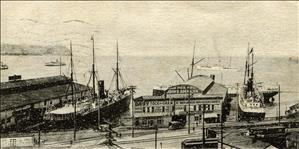On December 31, 1901, following a period of building on the waterfront to support the growing trade with Asia, the Chamber of Commerce reports: "Instead of the old irregular of wharfs and bunkers, there is now a complete chain of piers constructed along similar lines and in general conformity with each other ... .They represent a period of greatest development of the city" (Bermer, 23).
The Northern Pacific Railroad and the Pacific Coast Company, which owned the coalfields near the Green River, were primarily responsible for the construction of 18 piers and warehouses during 1900.
Sources:
Richard C. Berner, Seattle 1900-1920: From Boomtown, Urban Turbulence, to Restoration (Seattle, Charles Press, 1991), 23.
Licensing: This essay is licensed under a Creative Commons license that
encourages reproduction with attribution. Credit should be given to both
HistoryLink.org and to the author, and sources must be included with any
reproduction. Click the icon for more info. Please note that this
Creative Commons license applies to text only, and not to images. For
more information regarding individual photos or images, please contact
the source noted in the image credit.

Major Support for HistoryLink.org Provided
By:
The State of Washington | Patsy Bullitt Collins
| Paul G. Allen Family Foundation | Museum Of History & Industry
| 4Culture (King County Lodging Tax Revenue) | City of Seattle
| City of Bellevue | City of Tacoma | King County | The Peach
Foundation | Microsoft Corporation, Other Public and Private
Sponsors and Visitors Like You

